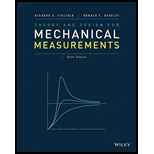
The recent stage of the developments in the instruments and data collection process for earthquake detection and monitoring, such as the force balance accelerometer.
Explanation of Solution
The recent development shows that the servo force balance accelerometer provide better performance and accuracy over the conventional accelerometers. These force balance accelerometer comprises a freely suspended mass controlled by an electrical equivalent
The servo force balance accelerometers can be broadly classified as the pendulous type, comprising an unbalanced pivoting mass providing angular displacement, and the non-pendulous type, comprising a mass which displaces rectilinearly. The basic operating principle for all these accelerometers is the Newton’s second law of motion which states that in order to accelerate a mass
Where,
These force balance accelerometers are designed for measuring DC and low frequencies, which are encountered during the motion of motor vehicles, aircrafts and ships. These accelerometers can measure levels from as low as
Want to see more full solutions like this?
Chapter 12 Solutions
Theory and Design for Mechanical Measurements
 Elements Of ElectromagneticsMechanical EngineeringISBN:9780190698614Author:Sadiku, Matthew N. O.Publisher:Oxford University Press
Elements Of ElectromagneticsMechanical EngineeringISBN:9780190698614Author:Sadiku, Matthew N. O.Publisher:Oxford University Press Mechanics of Materials (10th Edition)Mechanical EngineeringISBN:9780134319650Author:Russell C. HibbelerPublisher:PEARSON
Mechanics of Materials (10th Edition)Mechanical EngineeringISBN:9780134319650Author:Russell C. HibbelerPublisher:PEARSON Thermodynamics: An Engineering ApproachMechanical EngineeringISBN:9781259822674Author:Yunus A. Cengel Dr., Michael A. BolesPublisher:McGraw-Hill Education
Thermodynamics: An Engineering ApproachMechanical EngineeringISBN:9781259822674Author:Yunus A. Cengel Dr., Michael A. BolesPublisher:McGraw-Hill Education Control Systems EngineeringMechanical EngineeringISBN:9781118170519Author:Norman S. NisePublisher:WILEY
Control Systems EngineeringMechanical EngineeringISBN:9781118170519Author:Norman S. NisePublisher:WILEY Mechanics of Materials (MindTap Course List)Mechanical EngineeringISBN:9781337093347Author:Barry J. Goodno, James M. GerePublisher:Cengage Learning
Mechanics of Materials (MindTap Course List)Mechanical EngineeringISBN:9781337093347Author:Barry J. Goodno, James M. GerePublisher:Cengage Learning Engineering Mechanics: StaticsMechanical EngineeringISBN:9781118807330Author:James L. Meriam, L. G. Kraige, J. N. BoltonPublisher:WILEY
Engineering Mechanics: StaticsMechanical EngineeringISBN:9781118807330Author:James L. Meriam, L. G. Kraige, J. N. BoltonPublisher:WILEY





